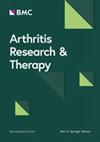探索bmp7衍生的p[63-82]肽的生物活性变异,以改善oa相关的软骨细胞表型
IF 4.6
2区 医学
Q1 Medicine
引用次数: 0
摘要
骨关节炎是一种高度流行的、与年龄相关的关节疾病,其特征是软骨变性、关节功能障碍和慢性疼痛。我们之前开发了一种骨形态发生蛋白7衍生肽p[63-82],这可能是OA的一种新的疾病改善治疗选择。在这项研究中,我们旨在优化该肽在关节内环境中的生物活性和生物稳定性,以评估这些肽治疗骨关节炎的治疗潜力。为优化p[63-82]的生物活性,设计合成了33个肽修饰。在全膝关节置换术中收集终末期骨关节炎患者的软骨细胞和滑液。为了验证生物活性的提高,进行了基因表达分析、糖胺聚糖含量、基质金属蛋白酶-13蛋白水平和碱性磷酸酶活性的测定。采用多种生化方法探索原p[63-82]肽的优化。一个环化肽(C2)能显著提高2型胶原的表达,降低10型胶原、基质金属蛋白酶-13和前列腺素内过氧化物合酶2的表达。尽管存在白介素-1β或骨关节炎滑膜液,相同浓度的线性p[63-82]肽和环肽变体C2仍能有效抑制SW1353细胞中的骨关节炎表型。然而,与p[63-82]相比,肽变体C2在降低骨关节炎-滑膜液暴露条件下基质金属蛋白酶-13蛋白水平方面具有更有利的生物活性。在较低浓度下,环状肽C2比线性肽p[63-82]表现出更高的生物活性。当评估这两种肽对原发性人关节软骨细胞的活性时,我们发现线性p[63-82]肽和肽C2抵消了原发性OA软骨细胞的肥大和炎症状态。该研究表明,在p[63-82]的各种测试修饰中,与线性肽p[63-82]相比,一个环变体(C2)在生物活性方面表现出相似的结果,而与原始p[63-82]肽相比,其他修饰的肽变体具有不活跃的生物活性特性。这突出了在不损害其生物活性的情况下增强肽特性的挑战,并强调了在治疗用途的肽修饰方面需要谨慎的方法。这项研究强调,虽然循环和其他结构变化可能带来好处,但它们应该在个案的基础上仔细评估。本文章由计算机程序翻译,如有差异,请以英文原文为准。
Exploration of bioactive variants of the BMP7-derived p[63–82] peptide for ameliorating the OA-associated chondrocyte phenotype
Osteoarthritis is a highly prevalent, age-associated joint disease characterized by cartilage degeneration, joint dysfunction, and chronic pain. We previously developed a bone morphogenetic protein 7 derived peptide p[63–82], which may be a novel disease-modifying treatment option for OA. In this study we aimed to optimize the bioactivity and biostability of this peptide in the intra-articular environment to evaluate the therapeutic potential of these peptides to treat osteoarthritis. 33 peptide modifications of p[63–82] were custom-designed and synthesized to optimize the bioactivity. Chondrocytes and synovial fluid were collected from end-stage osteoarthritic patients at total knee arthroplasty surgery. To validate improvements in bioactivity, gene expression analysis, glycosaminoglycan content, matrix metalloproteinase-13 protein levels and alkaline phosphatase activity was measured. Several biochemical approaches were used to explore optimization of the original p[63–82] peptide. One cyclized peptide (C2) was able to significantly increase the expression of collagen type 2 and decrease expression of collagen type 10, matrix metalloproteinase-13 and prostaglandin-endoperoxide synthase 2. The linear p[63–82] peptide and the cyclic peptide variant C2 in the same concentration were effective in suppressing the osteoartritic phenotype in SW1353 cells, despite the presence of interleukin-1β or osteoarthritic-synovial fluid. However, peptide variant C2 had a significantly more favorable bioactivity as compared to p[63–82] in reducing matrix metalloproteinase-13 protein levels in the osteoarthritic-synovial fluid exposed condition. At lower concentrations, the cyclic peptide C2 showed a higher bioactivity as compared to the linear p[63–82] peptide. When the activity of both peptides on primary human articular chondrocytes was evaluated, we found that the linear p[63–82] peptide as well as peptide C2 counteract the hypertrophic and inflammatory state of primary OA chondrocytes. This study demonstrates that among various tested modifications of p[63–82], one cyclic variant (C2) showed similar results in bioactivity as compared to the linear peptide p[63–82], whilst the other modified peptide variants had inactive bioactive properties as compared to the original p[63–82] peptide. This highlights the challenge in enhancing peptide properties without compromising their biological activity and emphasises the need for a cautious approach in peptide modification for therapeutic use. This research underscores that while cyclization and other structural changes may offer benefits, they should be carefully evaluated on a case-by-case basis.
求助全文
通过发布文献求助,成功后即可免费获取论文全文。
去求助
来源期刊

Arthritis Research & Therapy
RHEUMATOLOGY-
CiteScore
8.60
自引率
2.00%
发文量
261
审稿时长
14 weeks
期刊介绍:
Established in 1999, Arthritis Research and Therapy is an international, open access, peer-reviewed journal, publishing original articles in the area of musculoskeletal research and therapy as well as, reviews, commentaries and reports. A major focus of the journal is on the immunologic processes leading to inflammation, damage and repair as they relate to autoimmune rheumatic and musculoskeletal conditions, and which inform the translation of this knowledge into advances in clinical care. Original basic, translational and clinical research is considered for publication along with results of early and late phase therapeutic trials, especially as they pertain to the underpinning science that informs clinical observations in interventional studies.
 求助内容:
求助内容: 应助结果提醒方式:
应助结果提醒方式:


